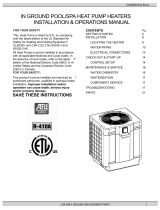
3. Installation
3.1 Location
1. The placement of the pool heater is very important in
keeping installation costs to a minimum while providing for
maximum efficiency of operation, as well as allowing
adequate access for service and maintenance.
2. The pool heat pump is designed for outdoor installation and
should not be installed in a fully enclosed area, such as a
shed, garage, etc. Recirculation of cold discharged air back
into the evaporator coil will greatly reduce unit heating
capacity and efficiency.
3. The unit should be located as close as practical to the
existing pool pump and filter to minimize water piping.
However, do not forget to provide a 24" clearance at the
very least all around your heat pump. The use of 90 degree
bends and short radius elbows in the water piping should
be kept to a minimum.
4. Mount the unit on a sturdy base, preferably a concrete slab
or a set of blocks. The base should be completely isolated
from the building foundation wall to prevent the possibility of
sound or vibration transmission into the building. The size
of the base should not be less than the size of the heat
pump.
Page 8 ENGLISH Installation & Operation Manual
te Air is pulled through the evaporator. Minimum clearance
of 72 inches should be allowed above air discharge. The unit
must not be installed under a porch. Any side of the unit
should be located at least 24 inches from obstructions for a
unrestricted air intake and service access.
3.2 Piping
1. The piping sequence is as follows: pool > pool pump >
filter > heater > corrosion-resistant check valve > chemical
feeder > pool. Automated chlorine distribution systems, if
used, must be placed downstream of the heater to
minimize harm to the pool equipment. Use rigid PVC
piping if possible.
2. All joints should be glued with PVC glue. When the piping
installation is complete, operate the pool pump and check
the system for leaks. Then, check the filter pressure gauge
to verify that there isn't any indication of excessive pump
head pressure.
You can also make the connections using high-pressure
flexible hose, but make sure the hose can withstand high
pressure.
3. The installation of a heat pump bypass is not necessary
unless the water flow exceeds 75 GPM.
te Certain installations have valves which isolate the
heat pump from the water circuit. If the heat exchanger is
deprived of water circulation for several days, high chlorine
gas could cause excessive corrosion. If the disconnect
switch is turned off, be sure that the pool water is allowed to
circulate through the unit, or is drained out of it.
3. Electrical Requirements
1. Install all equipment in accordance with the National
Electrical code and all applicable local codes and
ordinances.
2. The wiring of your pool heat pump should be performed
by a qualified licensed electrician in accordance with local
requirements. A properly-sized breaker and copper wire
must be used. Check the heat pump data label for
required maximum breaker size.
3. A means for disconnection must be incorporated in the
fixed wiring in accordance with the wiring rules.
Power to the unit, such as through a
breaker or external switch, must be turned off before
opening the access panel. Ensure that the unit has no
power BEFORE opening the access panel for any reason.
WARNING:




















